British actor Boris Karloff (1887-1969) is one of the true icons of the Horror cinema. He portrayed Frankenstein's monster in Frankenstein (1931), Bride of Frankenstein (1935), and Son of Frankenstein (1939), which resulted in his immense popularity. In the following decades he worked in countless Horror films, but also in other genres, both in Europe and Hollywood.
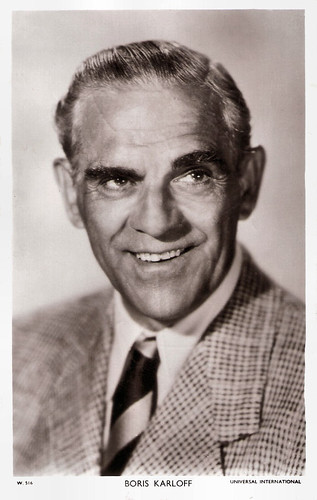
British postcard in the Picturegoer series, London, no W 516. Photo: Universal International.
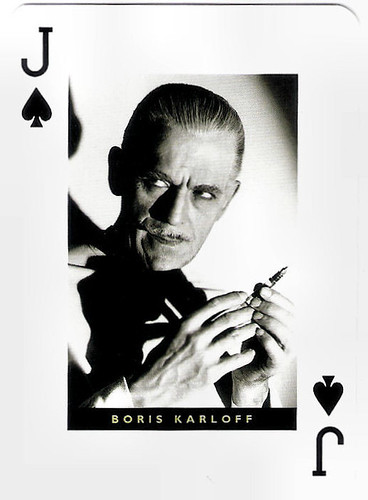
Vintage playing card.

British postcard in the Picturegoer series, London, no 707 H. Photo: Universal.
Boris Karloff was born William Henry Pratt in 1887 in London, England. Pratt himself stated that he was born in Dulwich, which is near London. His parents were Edward John Pratt, Jr. and his third wife Eliza Sarah Millard. ‘Billy’ never knew his father. Edward Pratt had worked for the Indian Salt Revenue Service and had virtually abandoned his family in far-off England. Edward died when his son was still an infant and so Billy was raised by his mother. He was the youngest of nine children, and following his mother's death was brought up by his elder brothers and sisters.
As a child, Billy performed each Christmas in plays staged by St. Mary Magdalene's Church. His first role was that of The Demon King in the pantomime Cinderella. Billy was bow-legged, had a lisp, and stuttered. He conquered his stutter, but not his lisp, which was noticeable throughout his career in the film industry. After his education at private schools, he attended King's College London where he took studies aimed at a career with the British Government's Consular Service. However, in 1909, the 22-year-old left university without graduating and sailed from Liverpool to Canada, where he worked as a farm labourer and did various odd itinerant jobs.
In Canada, he began appearing in theatrical performances and chose the stage name Boris Karloff. Later, he claimed he chose ‘Boris’ because it sounded foreign and exotic, and that ‘Karloff’ was a family name. However, his daughter Sara Karloff publicly denied any knowledge of Slavic forebears, Karloff or otherwise. One reason for the name change was to prevent embarrassment to his family. He did not reunite with his family until he returned to Britain to make The Ghoul (T. Hayes Hunter, 1933), opposite Cedric Hardwicke. Karloff was extremely worried that his family would disapprove of his new, macabre claim to world fame. Instead, his brothers jostled for position around him and happily posed for publicity photographs.
In 1911, Karloff joined the Jeanne Russell Company and later joined the Harry St. Clair Co. It performed in Minot, North Dakota, for a year in an opera house above a hardware store. Whilst he was trying to establish his acting career, Karloff had to perform years of difficult manual labour in Canada and the U.S. in order to make ends meet. He was left with back problems from which he suffered for the rest of his life. In 1917, he arrived in Hollywood, where he went on to make dozens of silent films. Some of his first roles were in film serials, such as The Masked Rider (Aubrey M. Kennedy, 1919), in Chapter 2 of which he can be glimpsed onscreen for the first time, and The Hope Diamond Mystery (Stuart Paton, 1920). In these early roles, he was often cast as an exotic Arabian or Indian villain.
Other silent films were The Deadlier Sex (Robert Thornby, 1920) with Blanche Sweet, Omar the Tentmaker (James Young, 1922), Dynamite Dan (Bruce Mitchell, 1924) and Tarzan and the Golden Lion (J.P. McGowan, 1927) in which James Pierce played Tarzan. In 1926 Karloff found a provocative role in The Bells (James Young, 1926), in which he played a sinister hypnotist opposite Lionel Barrymore. He worked with Barrymore again in his first sound film, the thriller The Unholy Night (Lionel Barrymore, 1929).

American postcard by Zoetrope Images Ltd., Boston, no 432. Photo: Boris Karloff in Frankenstein (James Whale, 1931).

American postcard by Classico San Francisco, no. 233/01. Photo: Universal Pictures. Publicity still for Frankenstein (James Whale, 1931).
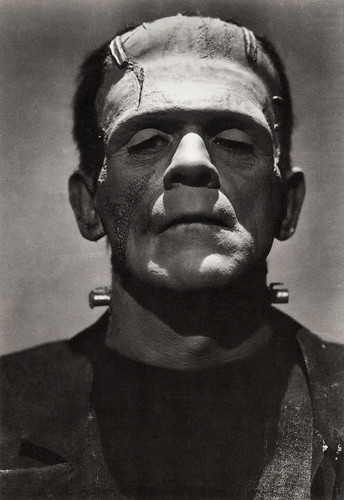
American postcard by Classico San Francisco, no. 233/06. Photo: Universal Pictures. Publicity still for Frankenstein (James Whale, 1931).
A key film which brought Boris Karloff recognition was The Criminal Code (Howard Hawks, 1931), a prison drama in which he reprised a dramatic part he had played on stage. With his characteristic short-cropped hair and menacing features, Karloff was a frightening sight to behold. Opposite Edward G. Robinson, Karloff played a key supporting part as an unethical newspaper reporter in Five Star Final (Mervyn LeRoy, 1931), a film about tabloid journalism which was nominated for the Oscar for Best Picture.
Karloff's role as Frankenstein's monster in Frankenstein (James Whale, 1931), based on the classic Mary Shelley book, propelled him to stardom. Wikipedia: “The bulky costume with four-inch platform boots made it an arduous role but the costume and extensive makeup produced the classic image. The costume was a job in itself for Karloff with the shoes weighing 11 pounds (5 kg) each.”
The aura of mystery surrounding Karloff was highlighted in the opening credits, as he was listed as simply "?." The film was a commercial and critical success for Universal, and Karloff was instantly established as a hot property in Hollywood. Universal Studios was quick to acquire ownership of the copyright to the makeup format for the Frankenstein monster that Jack P. Pierce had designed.
A year later, Karloff played another iconic character, Imhotep in The Mummy (Karl Freund, 1932). The Old Dark House (James Whale, 1932) with Charles Laughton, and the starring role in MGM’s The Mask of Fu Manchu (Charles Brabin, 1932) quickly followed. Steve Vertlieb at The Thunder Child: “Wonderfully kinky, the film co-starred young Myrna Loy as the intoxicating, yet sadistic Fah Lo See, Fu Manchu's sexually perverse daughter. Filmed before Hollywood's infamous production code, the film joyously escaped the later scrutiny of The Hayes Office, and remains a fascinating example of pre-code extravagance.”
These films all confirmed Karloff's new-found stardom. Horror had become his primary genre, and he gave a string of lauded performances in 1930s Universal Horror films. Karloff reprised the role of Frankenstein's monster in two other films, the sensational Bride of Frankenstein (James Whale, 1935) and the less thrilling Son of Frankenstein (Rowland V. Lee, 1939), the latter also featuring Bela Lugosi.
Steve Vertlieb about Bride of Frankenstein: “Whale delivered perhaps the greatest horror film of the decade and easily the most critically acclaimed rendition of Mary Shelley's novel ever released. The Bride of Frankenstein remains a work of sheer genius, a brilliantly conceived and realized take on loneliness, vanity, and madness. The cast of British character actors is simply superb.”
While the long, creative partnership between Karloff and Lugosi never led to a close friendship, it produced some of the actors' most revered and enduring productions, beginning with The Black Cat (Edgar G. Ullmer, 1934). Follow-ups included The Raven (Lew Landers, 1935), the rarely seen, imaginative science fiction melodrama The Invisible Ray (Lambert Hillyer, 1936), and The Body Snatcher (Robert Wise, 1945).
Karloff played a wide variety of roles in other genres besides Horror. He was memorably gunned down in a bowling alley in Howard Hawks' classic Scarface (1932) starring Paul Muni. He played a religious First World War soldier in John Ford’s epic The Lost Patrol (1934) opposite Victor McLaglen.
Between 1938 and 1940, Karloff starred in five films for Monogram Pictures, including Mr. Wong, Detective (William Nigh, 1938). During this period, he also starred with Basil Rathbone in Tower of London (Rowland V. Lee, 1939) as the murderous henchman of King Richard III, and with Margaret Lindsay in British Intelligence (Terry O. Morse, 1940). In 1944, he underwent a spinal operation to relieve his chronic arthritic condition.
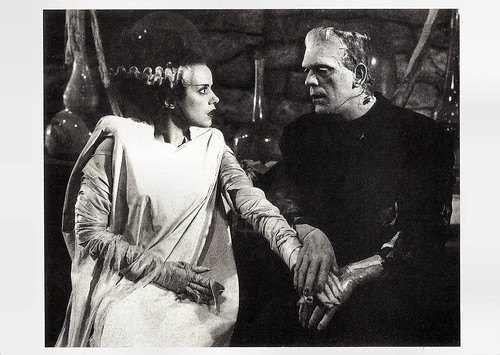
French postcard in the Collection Cinéma by Editions La Malibran, Paris, no. CA 53, 1989. Photo: Boris Karloff and Elsa Lanchester in Bride of Frankenstein (James Whale, 1935).

American postcard by Classico San Francisco, no. 233/007. Photo: Universal Pictures. Publicity still for The Bride of Frankenstein (James Whale, 1935) with Boris Karloff and Elsa Lanchester.
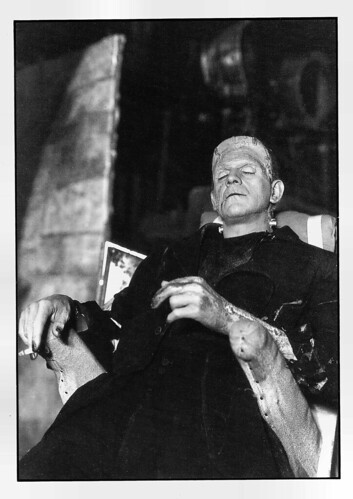
French postcard in the Entr'acte series by Editions aphodèle mâcon, no 001/09. Photo: Boris Karloff relaxing with a cigarette during an interval of the shooting of Bride of Frankenstein (James Whale, 1935).
Boris Karloff revisited the Frankenstein mythos in several later films, including taking the starring role of the villainous Dr. Niemann in House of Frankenstein (Erle C. Kenton, 1944), in which the monster was played by Glenn Strange. He reprised the role of the ‘mad scientist’ in Frankenstein 1970 (Howard W. Koch, 1958) as Baron Victor von Frankenstein II, the grandson of the original creator. The finale reveals that the crippled Baron has given his own face (i.e., Karloff's) to the monster. From 1945 to 1946, Boris Karloff appeared in three films for RKO produced by Val Lewton: Isle of the Dead (Mark Robson, 1945), The Body Snatcher (Robert Wise, 1945), and Bedlam (Mark Robson, 1946). Karloff had left Universal because he thought the Frankenstein franchise had run its course.
Karloff was a frequent guest on radio programs. In 1949, he was the host and star of the radio and television anthology series Starring Boris Karloff. In 1950, he had his own weekly children's radio show in New York. He played children's music, told stories and riddles, and attracted many adult listeners as well. An enthusiastic performer, he returned to the Broadway stage in the original production of 'Arsenic and Old Lace' (1941), in which he played a homicidal gangster enraged to be frequently mistaken for Karloff. In 1962, he reprised the role on television with Tony Randall and Tom Bosley. He also appeared as Captain Hook in the play 'Peter Pan' with Jean Arthur.
In 1955, he returned to the Broadway stage to portray the sympathetic Bishop Cauchon in Jean Anouilh's The Lark. Karloff regarded the production as the highlight of his long career. Julie Harris was his co-star as Joan of Arc in the celebrated play, recreated for live television in 1957 with Karloff, Harris and much of the original New York company intact. For his role, Karloff was nominated for a Tony Award. Karloff donned the monster make-up for the last time for a Halloween episode of the TV series Route 66 (1962), which also featured Peter Lorre and Lon Chaney, Jr. In the 1960s, Karloff appeared in several films for American International Pictures, including The Comedy of Terrors (Jacques Tourneur, 1963) with Vincent Price and Peter Lorre, The Raven (Roger Corman, 1963), The Terror (Roger Corman, 1963) with Jack Nicholson, and Die, Monster, Die! (Daniel Haller, 1965).
Another project for American International release was the frightening Italian horror classic I tre volti della paura/Black Sabbath (Mario Bava, 1963), in which Karloff played a vampire with bone-chilling intensity. He also starred in British cult director Michael Reeves's second feature film, The Sorcerers (1966). He gained new popularity among the young generation when he narrated the animated TV film Dr. Seuss' How the Grinch Stole Christmas (Chuck Jones, Ben Washam, 1966), and provided the voice of the Grinch. Karloff later received a Grammy Award for Best Recording For Children after the story was released as a record.
Then he starred as a retired horror film actor in Targets (Peter Bogdanovich, 1968). Steve Vertlieb: “Targets was a profoundly disturbing study of a young sniper holding a small Midwestern community, deep in the bible belt, terrifyingly at bay. The celebrated subplot concerned the philosophical dilemma of creating fanciful horrors on the screen, while the graphic, troubling reality was eclipsing the superficiality so tiredly repeated by Hollywood. Karloff co-starred, essentially as himself, an aged horror star named Byron Orlok, who wants simply to retire from the imagined horrors of a faded genre, only to come shockingly to grips with the depravity and genuine terror found on America's streets. Bogdanovich's first film as a director won praise from critics and audiences throughout the world community, and won its elder star the best, most respectful notices of his later career.”
In 1968, he played occult expert Professor Marsh in the British production Curse of the Crimson Altar (Vernon Sewell, 1968), which was the last Karloff film to be released during his lifetime. He ended his career by appearing in four low-budget Mexican horror films, which were released posthumously. While shooting his final films, Karloff suffered from emphysema. Only half of one lung was still functioning and he required oxygen between takes. he contracted bronchitis in 1968 and was hospitalised. In early 1969, he died of pneumonia at the King Edward VII Hospital, Midhurst, in Sussex, at the age of 81. Boris Karloff married five times and had one child, daughter Sara Karloff, by his fourth wife.
Trailer The Mummy (1932). Source: The Mummy (Karl Freund, 1932). (YouTube).
Trailer Bride of Frankenstein (1935). Source: Movieclips (YouTube).
Trailer for I tre volti della paura/Black Sabbath (1963). Source: revokcom (YouTube).
Sources: Steve Vertlieb (The Thunder Child), Wikipedia, and IMDb.
This post was last updated on 4 December 2024.

British postcard in the Picturegoer series, London, no W 516. Photo: Universal International.

Vintage playing card.

British postcard in the Picturegoer series, London, no 707 H. Photo: Universal.
An exotic Arabian or Indian villain
Boris Karloff was born William Henry Pratt in 1887 in London, England. Pratt himself stated that he was born in Dulwich, which is near London. His parents were Edward John Pratt, Jr. and his third wife Eliza Sarah Millard. ‘Billy’ never knew his father. Edward Pratt had worked for the Indian Salt Revenue Service and had virtually abandoned his family in far-off England. Edward died when his son was still an infant and so Billy was raised by his mother. He was the youngest of nine children, and following his mother's death was brought up by his elder brothers and sisters.
As a child, Billy performed each Christmas in plays staged by St. Mary Magdalene's Church. His first role was that of The Demon King in the pantomime Cinderella. Billy was bow-legged, had a lisp, and stuttered. He conquered his stutter, but not his lisp, which was noticeable throughout his career in the film industry. After his education at private schools, he attended King's College London where he took studies aimed at a career with the British Government's Consular Service. However, in 1909, the 22-year-old left university without graduating and sailed from Liverpool to Canada, where he worked as a farm labourer and did various odd itinerant jobs.
In Canada, he began appearing in theatrical performances and chose the stage name Boris Karloff. Later, he claimed he chose ‘Boris’ because it sounded foreign and exotic, and that ‘Karloff’ was a family name. However, his daughter Sara Karloff publicly denied any knowledge of Slavic forebears, Karloff or otherwise. One reason for the name change was to prevent embarrassment to his family. He did not reunite with his family until he returned to Britain to make The Ghoul (T. Hayes Hunter, 1933), opposite Cedric Hardwicke. Karloff was extremely worried that his family would disapprove of his new, macabre claim to world fame. Instead, his brothers jostled for position around him and happily posed for publicity photographs.
In 1911, Karloff joined the Jeanne Russell Company and later joined the Harry St. Clair Co. It performed in Minot, North Dakota, for a year in an opera house above a hardware store. Whilst he was trying to establish his acting career, Karloff had to perform years of difficult manual labour in Canada and the U.S. in order to make ends meet. He was left with back problems from which he suffered for the rest of his life. In 1917, he arrived in Hollywood, where he went on to make dozens of silent films. Some of his first roles were in film serials, such as The Masked Rider (Aubrey M. Kennedy, 1919), in Chapter 2 of which he can be glimpsed onscreen for the first time, and The Hope Diamond Mystery (Stuart Paton, 1920). In these early roles, he was often cast as an exotic Arabian or Indian villain.
Other silent films were The Deadlier Sex (Robert Thornby, 1920) with Blanche Sweet, Omar the Tentmaker (James Young, 1922), Dynamite Dan (Bruce Mitchell, 1924) and Tarzan and the Golden Lion (J.P. McGowan, 1927) in which James Pierce played Tarzan. In 1926 Karloff found a provocative role in The Bells (James Young, 1926), in which he played a sinister hypnotist opposite Lionel Barrymore. He worked with Barrymore again in his first sound film, the thriller The Unholy Night (Lionel Barrymore, 1929).

American postcard by Zoetrope Images Ltd., Boston, no 432. Photo: Boris Karloff in Frankenstein (James Whale, 1931).

American postcard by Classico San Francisco, no. 233/01. Photo: Universal Pictures. Publicity still for Frankenstein (James Whale, 1931).

American postcard by Classico San Francisco, no. 233/06. Photo: Universal Pictures. Publicity still for Frankenstein (James Whale, 1931).
A frightening sight to behold
A key film which brought Boris Karloff recognition was The Criminal Code (Howard Hawks, 1931), a prison drama in which he reprised a dramatic part he had played on stage. With his characteristic short-cropped hair and menacing features, Karloff was a frightening sight to behold. Opposite Edward G. Robinson, Karloff played a key supporting part as an unethical newspaper reporter in Five Star Final (Mervyn LeRoy, 1931), a film about tabloid journalism which was nominated for the Oscar for Best Picture.
Karloff's role as Frankenstein's monster in Frankenstein (James Whale, 1931), based on the classic Mary Shelley book, propelled him to stardom. Wikipedia: “The bulky costume with four-inch platform boots made it an arduous role but the costume and extensive makeup produced the classic image. The costume was a job in itself for Karloff with the shoes weighing 11 pounds (5 kg) each.”
The aura of mystery surrounding Karloff was highlighted in the opening credits, as he was listed as simply "?." The film was a commercial and critical success for Universal, and Karloff was instantly established as a hot property in Hollywood. Universal Studios was quick to acquire ownership of the copyright to the makeup format for the Frankenstein monster that Jack P. Pierce had designed.
A year later, Karloff played another iconic character, Imhotep in The Mummy (Karl Freund, 1932). The Old Dark House (James Whale, 1932) with Charles Laughton, and the starring role in MGM’s The Mask of Fu Manchu (Charles Brabin, 1932) quickly followed. Steve Vertlieb at The Thunder Child: “Wonderfully kinky, the film co-starred young Myrna Loy as the intoxicating, yet sadistic Fah Lo See, Fu Manchu's sexually perverse daughter. Filmed before Hollywood's infamous production code, the film joyously escaped the later scrutiny of The Hayes Office, and remains a fascinating example of pre-code extravagance.”
These films all confirmed Karloff's new-found stardom. Horror had become his primary genre, and he gave a string of lauded performances in 1930s Universal Horror films. Karloff reprised the role of Frankenstein's monster in two other films, the sensational Bride of Frankenstein (James Whale, 1935) and the less thrilling Son of Frankenstein (Rowland V. Lee, 1939), the latter also featuring Bela Lugosi.
Steve Vertlieb about Bride of Frankenstein: “Whale delivered perhaps the greatest horror film of the decade and easily the most critically acclaimed rendition of Mary Shelley's novel ever released. The Bride of Frankenstein remains a work of sheer genius, a brilliantly conceived and realized take on loneliness, vanity, and madness. The cast of British character actors is simply superb.”
While the long, creative partnership between Karloff and Lugosi never led to a close friendship, it produced some of the actors' most revered and enduring productions, beginning with The Black Cat (Edgar G. Ullmer, 1934). Follow-ups included The Raven (Lew Landers, 1935), the rarely seen, imaginative science fiction melodrama The Invisible Ray (Lambert Hillyer, 1936), and The Body Snatcher (Robert Wise, 1945).
Karloff played a wide variety of roles in other genres besides Horror. He was memorably gunned down in a bowling alley in Howard Hawks' classic Scarface (1932) starring Paul Muni. He played a religious First World War soldier in John Ford’s epic The Lost Patrol (1934) opposite Victor McLaglen.
Between 1938 and 1940, Karloff starred in five films for Monogram Pictures, including Mr. Wong, Detective (William Nigh, 1938). During this period, he also starred with Basil Rathbone in Tower of London (Rowland V. Lee, 1939) as the murderous henchman of King Richard III, and with Margaret Lindsay in British Intelligence (Terry O. Morse, 1940). In 1944, he underwent a spinal operation to relieve his chronic arthritic condition.

French postcard in the Collection Cinéma by Editions La Malibran, Paris, no. CA 53, 1989. Photo: Boris Karloff and Elsa Lanchester in Bride of Frankenstein (James Whale, 1935).

American postcard by Classico San Francisco, no. 233/007. Photo: Universal Pictures. Publicity still for The Bride of Frankenstein (James Whale, 1935) with Boris Karloff and Elsa Lanchester.

French postcard in the Entr'acte series by Editions aphodèle mâcon, no 001/09. Photo: Boris Karloff relaxing with a cigarette during an interval of the shooting of Bride of Frankenstein (James Whale, 1935).
Bone-chilling intensity
Boris Karloff revisited the Frankenstein mythos in several later films, including taking the starring role of the villainous Dr. Niemann in House of Frankenstein (Erle C. Kenton, 1944), in which the monster was played by Glenn Strange. He reprised the role of the ‘mad scientist’ in Frankenstein 1970 (Howard W. Koch, 1958) as Baron Victor von Frankenstein II, the grandson of the original creator. The finale reveals that the crippled Baron has given his own face (i.e., Karloff's) to the monster. From 1945 to 1946, Boris Karloff appeared in three films for RKO produced by Val Lewton: Isle of the Dead (Mark Robson, 1945), The Body Snatcher (Robert Wise, 1945), and Bedlam (Mark Robson, 1946). Karloff had left Universal because he thought the Frankenstein franchise had run its course.
Karloff was a frequent guest on radio programs. In 1949, he was the host and star of the radio and television anthology series Starring Boris Karloff. In 1950, he had his own weekly children's radio show in New York. He played children's music, told stories and riddles, and attracted many adult listeners as well. An enthusiastic performer, he returned to the Broadway stage in the original production of 'Arsenic and Old Lace' (1941), in which he played a homicidal gangster enraged to be frequently mistaken for Karloff. In 1962, he reprised the role on television with Tony Randall and Tom Bosley. He also appeared as Captain Hook in the play 'Peter Pan' with Jean Arthur.
In 1955, he returned to the Broadway stage to portray the sympathetic Bishop Cauchon in Jean Anouilh's The Lark. Karloff regarded the production as the highlight of his long career. Julie Harris was his co-star as Joan of Arc in the celebrated play, recreated for live television in 1957 with Karloff, Harris and much of the original New York company intact. For his role, Karloff was nominated for a Tony Award. Karloff donned the monster make-up for the last time for a Halloween episode of the TV series Route 66 (1962), which also featured Peter Lorre and Lon Chaney, Jr. In the 1960s, Karloff appeared in several films for American International Pictures, including The Comedy of Terrors (Jacques Tourneur, 1963) with Vincent Price and Peter Lorre, The Raven (Roger Corman, 1963), The Terror (Roger Corman, 1963) with Jack Nicholson, and Die, Monster, Die! (Daniel Haller, 1965).
Another project for American International release was the frightening Italian horror classic I tre volti della paura/Black Sabbath (Mario Bava, 1963), in which Karloff played a vampire with bone-chilling intensity. He also starred in British cult director Michael Reeves's second feature film, The Sorcerers (1966). He gained new popularity among the young generation when he narrated the animated TV film Dr. Seuss' How the Grinch Stole Christmas (Chuck Jones, Ben Washam, 1966), and provided the voice of the Grinch. Karloff later received a Grammy Award for Best Recording For Children after the story was released as a record.
Then he starred as a retired horror film actor in Targets (Peter Bogdanovich, 1968). Steve Vertlieb: “Targets was a profoundly disturbing study of a young sniper holding a small Midwestern community, deep in the bible belt, terrifyingly at bay. The celebrated subplot concerned the philosophical dilemma of creating fanciful horrors on the screen, while the graphic, troubling reality was eclipsing the superficiality so tiredly repeated by Hollywood. Karloff co-starred, essentially as himself, an aged horror star named Byron Orlok, who wants simply to retire from the imagined horrors of a faded genre, only to come shockingly to grips with the depravity and genuine terror found on America's streets. Bogdanovich's first film as a director won praise from critics and audiences throughout the world community, and won its elder star the best, most respectful notices of his later career.”
In 1968, he played occult expert Professor Marsh in the British production Curse of the Crimson Altar (Vernon Sewell, 1968), which was the last Karloff film to be released during his lifetime. He ended his career by appearing in four low-budget Mexican horror films, which were released posthumously. While shooting his final films, Karloff suffered from emphysema. Only half of one lung was still functioning and he required oxygen between takes. he contracted bronchitis in 1968 and was hospitalised. In early 1969, he died of pneumonia at the King Edward VII Hospital, Midhurst, in Sussex, at the age of 81. Boris Karloff married five times and had one child, daughter Sara Karloff, by his fourth wife.
Trailer The Mummy (1932). Source: The Mummy (Karl Freund, 1932). (YouTube).
Trailer Bride of Frankenstein (1935). Source: Movieclips (YouTube).
Trailer for I tre volti della paura/Black Sabbath (1963). Source: revokcom (YouTube).
Sources: Steve Vertlieb (The Thunder Child), Wikipedia, and IMDb.
This post was last updated on 4 December 2024.
No comments:
Post a Comment